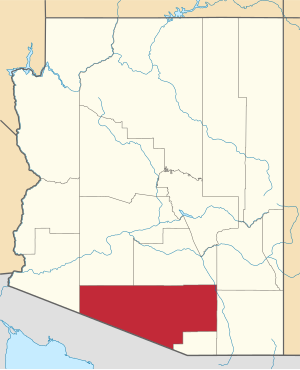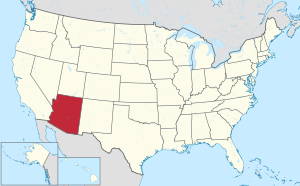Pima County, Arizona: Difference between revisions
Deflective (talk | contribs) standardizing IPAc-en calls using AWB |
Paul.colbert (talk | contribs) |
||
| Line 206: | Line 206: | ||
==External links== |
==External links== |
||
*[http://www.pima.gov/ Official website] |
*[http://www.pima.gov/ Official website] |
||
*[http://www.inmatecountyjail.com/cat/pima-county/ Pima County Detention Facilities] |
|||
{{Geographic Location |
{{Geographic Location |
||
Revision as of 23:08, 5 June 2013
This article needs additional citations for verification. (May 2007) |
Pima County | |
|---|---|
 Pima County Courthouse in Tucson, Arizona | |
 Location within the U.S. state of Arizona | |
 Arizona's location within the U.S. | |
| Coordinates: 32°03′55″N 111°49′15″W / 32.0653°N 111.8208°W | |
| Country | |
| State | |
| Founded | November 9, 1864 |
| Seat | Tucson |
| Largest city | Tucson |
| Area | |
| • Total | 9,188.83 sq mi (23,799.0 km2) |
| • Land | 9,186.27 sq mi (23,792.3 km2) |
| • Water | 2.57 sq mi (6.7 km2) 0.03% |
| Population | |
| • Estimate (2011) | 989,569 |
| • Density | 107/sq mi (41.2/km2) |
| Time zone | UTC−7 (Mountain) |
| Website | www |

Pima County /ˈpiːmə/ is a county in the south central region of the U.S. state of Arizona. The county is named after the Pima Native Americans which are indigenous to this area. The population was 980,263 at the 2010 census. The county seat is Tucson,Template:GR where nearly all of the population is centered. It borders between southwestern Arizona and northwestern Mexico's Sonora state.
Pima County contains parts of the Tohono O'odham Nation, as well as all of the San Xavier Indian Reservation, the Pascua Yaqui Indian Reservation, Organ Pipe Cactus National Monument, Ironwood Forest National Monument and Saguaro National Park.
The vast majority of the county population lies in and around the city of Tucson (2011 city population: 525,796), filling much of the eastern part of the county with urban development. Tucson, Arizona's second largest city, is a major commercial and academic center. Other urban areas include the Tucson suburbs of Oro Valley (population 41,335), Marana (population 35,232), Sahuarita (population 25,458), and South Tucson (population 5,695), a large ring of unincorporated urban development, and the growing satellite town Green Valley. The rest of the county is sparsely populated; the largest towns are Sells, the capital of the Tohono O'odham Nation, and Ajo in the far western region of the county.
History
Pima County, one of the four original counties in Arizona, was created by the 1st Arizona Territorial Legislature with land acquired through the Gadsden Purchase from Mexico in 1853. The original county consisted of all of Arizona Territory east of longitude 113° 20' and south of the Gila River.[1] Soon thereafter, the counties of Cochise, Graham and Santa Cruz were carved from the original Pima County.[2]
Geography
According to the 2000 census, the county has a total area of 9,188.83 square miles (23,799.0 km2), of which 9,186.27 square miles (23,792.3 km2) (or 99.97%) is land and 2.57 square miles (6.7 km2) (or 0.03%) is water.[3]
Topographic features
Major highways
 Interstate 10
Interstate 10 Interstate 19
Interstate 19 State Route 77
State Route 77 State Route 83
State Route 83 State Route 85
State Route 85 State Route 86
State Route 86 State Route 210
State Route 210
Adjacent counties and municipios
- Yuma County, Arizona – west
- Maricopa County, Arizona – north
- Pinal County, Arizona – north
- Graham County, Arizona – northeast
- Cochise County, Arizona – east
- Santa Cruz County, Arizona – southeast
- Altar, Sonora, Mexico – south
- Caborca, Sonora, Mexico – south
- Plutarco Elías Calles, Sonora, Mexico – south
- Sáric, Sonora, Mexico – south
National protected areas
- Buenos Aires National Wildlife Refuge
- Cabeza Prieta National Wildlife Refuge (part)
- Coronado National Forest (part)
- Ironwood Forest National Monument (part)
- Las Cienegas National Conservation Area (part)
- Organ Pipe Cactus National Monument
- Saguaro National Park
Metropolitan Statistical Area
The United States Office of Management and Budget has designated Pima County as the Tucson, AZ Metropolitan Statistical Area.[4] The United States Census Bureau ranked the Tucson, AZ Metropolitan Statistical Area as the 53rd most populous metropolitan statistical area of the United States as of July 1, 2012.[5]
The Office of Management and Budget has further designated the Tucson, AZ Metropolitan Statistical Area as a component of the more extensive Tucson-Nogales, AZ Combined Statistical Area,[4] the 53rd most populous combined statistical area and the 59th most populous primary statistical area of the United States as of July 1, 2012.[5][6]
Demographics
| Census | Pop. | Note | %± |
|---|---|---|---|
| 1870 | 5,716 | — | |
| 1880 | 17,006 | 197.5% | |
| 1890 | 12,673 | −25.5% | |
| 1900 | 14,689 | 15.9% | |
| 1910 | 22,818 | 55.3% | |
| 1920 | 34,680 | 52.0% | |
| 1930 | 55,676 | 60.5% | |
| 1940 | 72,838 | 30.8% | |
| 1950 | 141,216 | 93.9% | |
| 1960 | 265,660 | 88.1% | |
| 1970 | 351,667 | 32.4% | |
| 1980 | 531,443 | 51.1% | |
| 1990 | 666,880 | 25.5% | |
| 2000 | 843,746 | 26.5% | |
| 2010 | 980,263 | 16.2% | |
| 2012 (est.) | 992,394 | 1.2% | |
2011 estimate | |||
2010
Whereas according to the 2010 U.S. Census Bureau:
- 74.3% White
- 3.5% Black
- 3.3% Native American
- 2.6% Asian
- 0.2% Native Hawaiian or Pacific Islander
- 3.7% Two or more races
- 12.4% Other races
- 34.6% Hispanic or Latino (of any race)
2000
As of the 2000 census, there were 843,746 people, 332,350 households, and 212,039 families residing in the county. The population density was 92 people per square mile (35/km²). There were 366,737 housing units at an average density of 40 per square mile (15/km²). The racial makeup of the county was 75.07% White, 3.03% Black or African American, 3.22% Native American, 2.04% Asian, 0.13% Pacific Islander, 13.30% from other races, and 3.21% from two or more races. 29.34% of the population were Hispanic or Latino of any race. 22.80% reported speaking Spanish at home [1].
There were 332,350 households out of which 29.20% had children under the age of 18 living with them, 47.70% were married couples living together, 11.80% had a female householder with no husband present, and 36.20% were non-families. 28.50% of all households were made up of individuals and 9.40% had someone living alone who was 65 years of age or older. The average household size was 2.47 and the average family size was 3.06.
In the county the population was spread out with 24.60% under the age of 18, 10.90% from 18 to 24, 28.40% from 25 to 44, 21.90% from 45 to 64, and 14.20% who were 65 years of age or older. The median age was 36 years. For every 100 females there were 95.70 males. For every 100 females age 18 and over, there were 92.70 males.
The median income for a household in the county was $36,758, and the median income for a family was $44,446. Males had a median income of $32,156 versus $24,959 for females. The per capita income for the county was $19,785. About 10.50% of families and 14.70% of the population were below the poverty line, including 19.40% of those under age 18 and 8.20% of those age 65 or over.
Communities


CitiesTownsOther communitiesIndian reservations
|
Census-designated places |
See also
Tourist attractions
- Pima County Fair
- Arizona-Sonora Desert Museum
- Old Tucson
- Arizona Historical Society (museum)
- Tucson Gem & Mineral Show
- Titan Missile Museum
- Biosphere 2
- Mission San Xavier del Bac
References
- ^ Wagoner, Jay J. (1970). Arizona Territory 1863–1912: A Political history. Tucson: University of Arizona Press. p. 58. ISBN 0-8165-0176-9.
- ^ "History: Pima County". Pima County Justice Court (jp.pima.gov). September 27, 2000. Retrieved 2009-09-30.
{{cite web}}: External link in|publisher= - ^ "Census 2000 U.S. Gazetteer Files: Counties". United States Census. Retrieved 2011-02-13.
- ^ a b "OMB Bulletin No. 13-01: Revised Delineations of Metropolitan Statistical Areas, Micropolitan Statistical Areas, and Combined Statistical Areas, and Guidance on Uses of the Delineations of These Areas" (PDF). United States Office of Management and Budget. February 28, 2013. Retrieved March 20, 2013.
- ^ a b "Table 1. Annual Estimates of the Population of Metropolitan and Micropolitan Statistical Areas: April 1, 2010 to July 1, 2012" (CSV). 2012 Population Estimates. United States Census Bureau, Population Division. March 2013. Retrieved March 20, 2013.
- ^ "Table 2. Annual Estimates of the Population of Combined Statistical Areas: April 1, 2010 to July 1, 2012" (CSV). 2012 Population Estimates. United States Census Bureau, Population Division. March 2013. Retrieved March 20, 2013.

